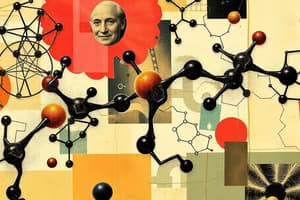Podcast
Questions and Answers
What is the effect of an allosteric modulator on the binding of an agonist to the receptor?
What is the effect of an allosteric modulator on the binding of an agonist to the receptor?
- It inhibits the binding of the agonist (correct)
- It enhances the binding of the agonist
- It has no effect on the binding of the agonist
- It causes a conformational change in the receptor
What happens to the ion channel when the alpha unit of the G protein breaks off?
What happens to the ion channel when the alpha unit of the G protein breaks off?
- It opens (correct)
- It is deactivated
- It remains open
- It closes
What is the result of chronic antagonism?
What is the result of chronic antagonism?
- Up-regulation of the receptor
- Down-regulation of the receptor (correct)
- No change in the receptor
- Desensitization of the receptor
What is the role of the beta and gamma units of the G protein?
What is the role of the beta and gamma units of the G protein?
What is the effect of an antagonist on the receptor?
What is the effect of an antagonist on the receptor?
What is the type of bond that allows substrate to bind to the receptor?
What is the type of bond that allows substrate to bind to the receptor?
What is the effect of an allosteric antagonist on the receptor?
What is the effect of an allosteric antagonist on the receptor?
Flashcards are hidden until you start studying
Study Notes
Drug-Receptor Interactions
- Single transmembrane proteins often combine to form enzymes that function in a soluble form.
- Weak bonds between substrates enhance receptor binding capabilities.
- There is a significant difference in receptor binding, with some capable of binding 1000 times more effectively than others.
Drug Affinity and Response
- To achieve Emax (maximum effect), higher doses are often required for compounds with lower affinity.
- An example involves a drug that binds to 50% of its target response, implying that dosing strategies must be optimized to reach Emax effectively.
Mechanisms of Drug Action
- Drugs can act as orthosteric (binding on the same site as the agonist) or allosteric (binding on a different site) agents.
- Allosteric modulators can induce conformational changes that enhance or inhibit receptor activity.
- Competitive antagonists block the orthosteric site, while allosteric antagonists can negatively impact receptor function through different mechanisms.
Receptor Dynamics
- The amount of response is proportionate to the number of occupied receptors, highlighting the significance of receptor occupancy in drug efficacy.
- Specific concentrations, such as nanomolar or micromolar ranges, are critical in gauging the effectiveness of a drug.
Ion Channel Regulation
- Drug actions include modulation of ion flow through channels, affecting cell polarization (depolarization/hyperpolarization).
- Activation of alpha units in G-proteins leads to cyclase activity, which regulates secondary messengers like cAMP.
- Beta and gamma subunits can also affect ion channels, influencing cellular excitability and responsiveness.
Chronic Antagonism
- Long-term antagonism can lead to changes in receptor sensitivity and function, affecting overall therapeutic outcomes.
Studying That Suits You
Use AI to generate personalized quizzes and flashcards to suit your learning preferences.




